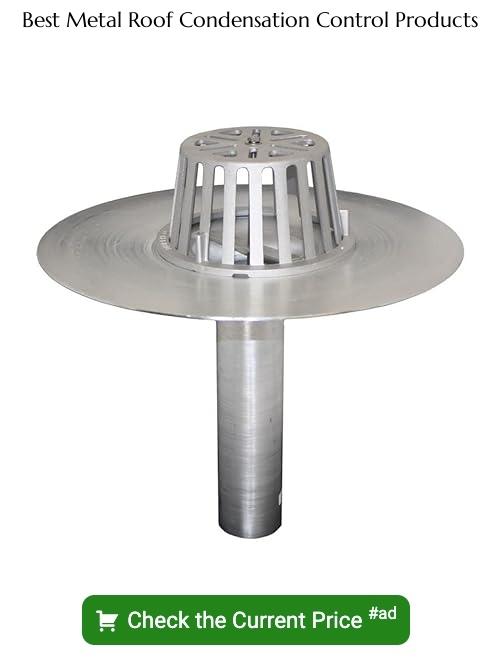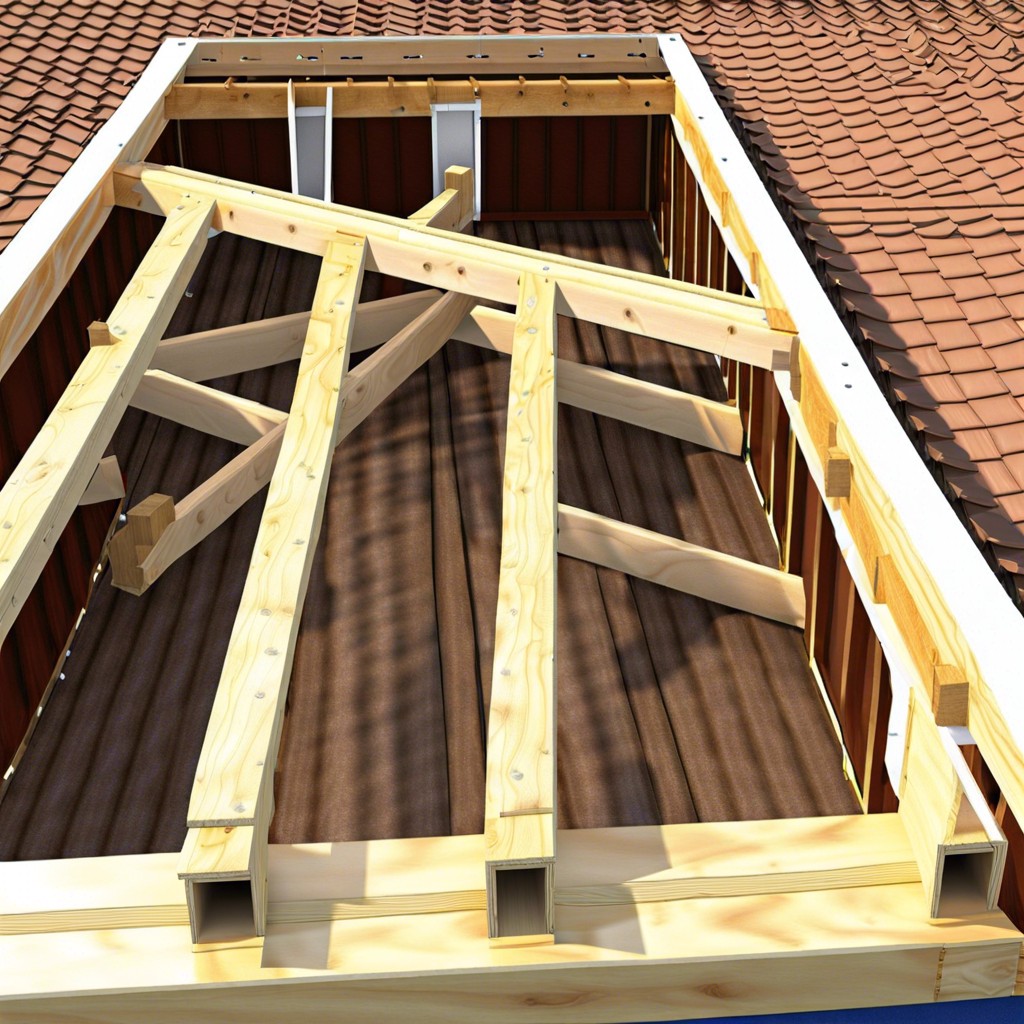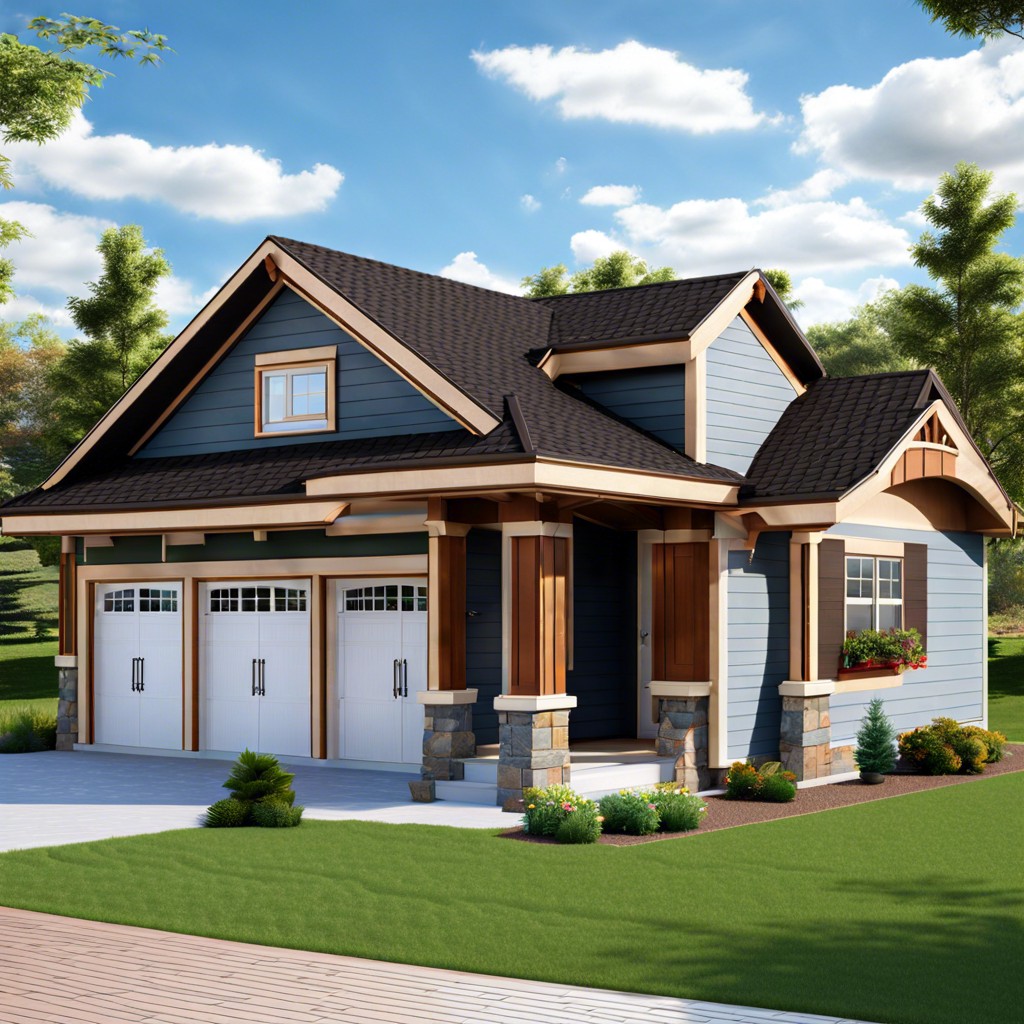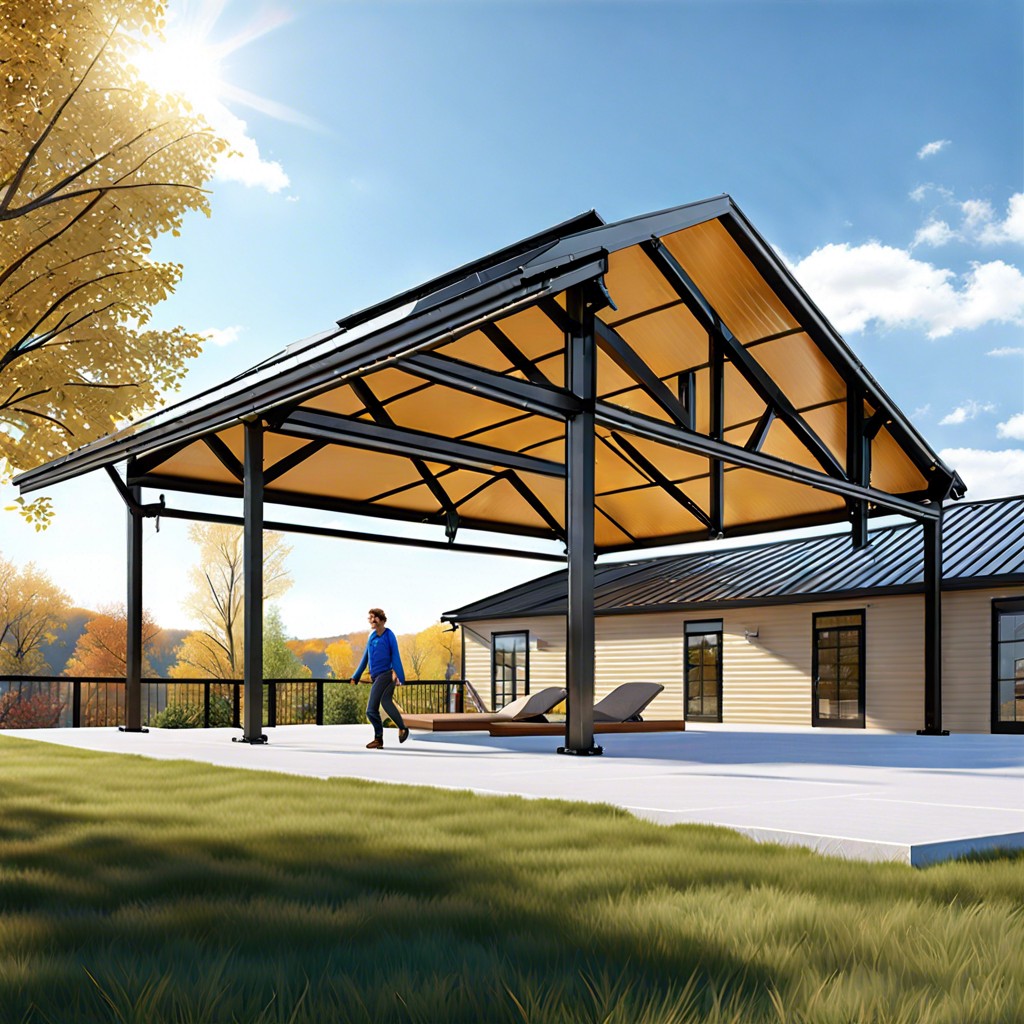Last updated on
Discover the most effective ways to prevent metal roof sweating and protect your home from potential damage with our practical tips and solutions.
Are you tired of constantly dealing with a wet and slippery metal roof? Metal roofs are known to sweat, especially during humid weather conditions. This can lead to water damage, mold growth, and even accidents due to the slippery surface.
Fortunately, there are ways to prevent metal roof sweating and keep your roof dry and safe. In this article, we will be discussing some effective tips on how to stop metal roof sweating so that you can enjoy a worry-free roofing experience.
So let’s dive in!
Understanding Metal Roof Sweating
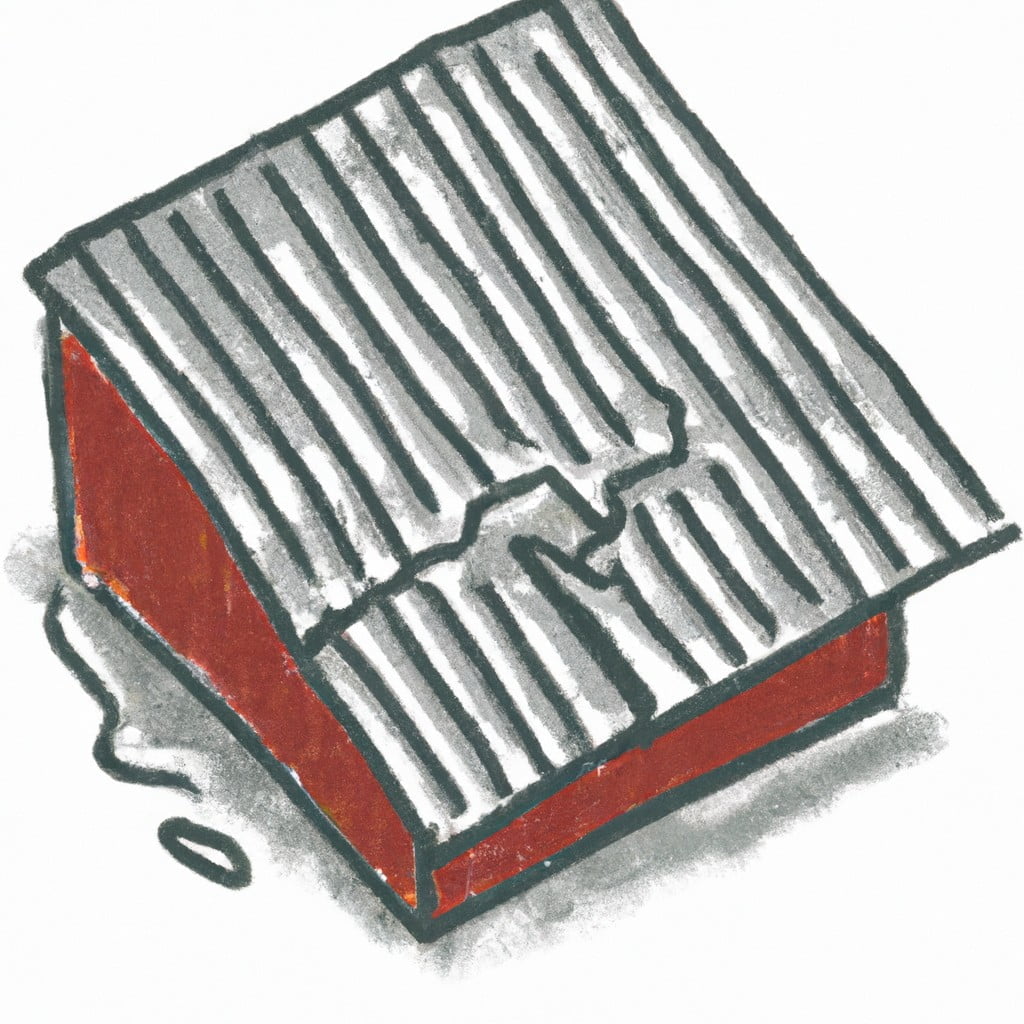
Metal roof sweating is a common issue that many homeowners face. It occurs when moisture builds up on the underside of the metal roofing panels, causing water droplets to form and eventually drip onto your ceiling or attic space.
This can lead to serious problems such as mold growth, rotting wood, and even structural damage if left unchecked.
Understanding why metal roofs sweat is crucial in preventing this problem from occurring. One of the main causes of metal roof sweating is poor ventilation.
When there isn’t enough air circulation underneath your roof, warm moist air gets trapped inside and condenses on the cold surface of your metal roofing panels.
Another factor that contributes to this issue is high humidity levels indoors. If you live in an area with high humidity or have activities like cooking or showering that generate moisture inside your home without proper ventilation systems installed then it will increase indoor humidity levels which can cause more condensation on a cold surface like a metallic rooftop panel.
Causes of Metal Roof Sweating
This can happen due to several reasons, including poor ventilation, high humidity levels inside your home or building, and temperature fluctuations. When warm air rises from inside your home or building and meets with a cold metal surface, it creates an ideal environment for condensation to form.
Another common cause of metal roof sweating is inadequate insulation. Without proper insulation in place, heat escapes through the ceiling during colder months and warms up the underside of your metal roofing material.
As temperatures fluctuate throughout the day or night, this can lead to moisture buildup on top of your roofing panels.
It’s important to identify what’s causing your metal roof sweating so that you can take appropriate measures before any damage occurs.
Importance of Proper Ventilation
Without adequate air circulation, moisture can accumulate and condense on the underside of the roof, leading to water damage and mold growth. In addition to protecting your home from potential damage, proper ventilation also helps regulate indoor temperature and improve energy efficiency.
There are several effective methods for ensuring proper air circulation under a metal roof. One option is installing vents that allow hot air to escape while drawing in cooler outside air.
Another method involves using ridge vents or soffit vents that create a continuous flow of fresh air through the attic space.
It’s important to note that different types of roofs require different venting systems based on their design and construction materials. Consulting with a roofing professional can help you determine which type of ventilation system will work best for your specific needs.
Effective Air Circulation Methods
This can be achieved through various methods, including natural ventilation and mechanical ventilation.
Natural Ventilation: Natural ventilation involves creating openings in your attic or roof space that allow for the free flow of air. These openings can be created through vents installed on the eaves, gable ends, or ridge of your roof.
The vents work by allowing cool outside air to enter and warm moist air to escape from inside.
Mechanical Ventilation: Mechanical ventilation involves using fans and other equipment to circulate air within your attic or roof space. This method is particularly useful for homes with limited natural airflow due to design constraints such as low-pitched roofs.
Regardless of which method you choose, it’s important that you ensure adequate airflow throughout all areas under the metal roofing material. Properly ventilating a metal-roofed structure will not only help prevent condensation but also improve energy efficiency while extending its lifespan.
Vent Selection and Installation
The right vent selection and installation can help to regulate the temperature of your attic, reduce humidity levels, and prevent moisture buildup. There are different types of vents available on the market such as ridge vents, soffit vents, gable-end vents or turbine ventilators.
Ridge Vents: These are installed at the peak of a sloped roof to allow hot air to escape from inside your attic space.
Soffit Vents: These are installed under the eaves or overhangs along with intake ventilation that allows cool air into your attic space.
Gable-End Vents: They work by allowing hot air out through a wall opening near each end of an attic’s ridge line while drawing cooler outside air in through lower-level soffits.
Turbine Ventilators: They use wind power to draw warm moist air out from inside an enclosed area like attics or garages.
The type you choose will depend on various factors such as climate conditions, roofing material used among others. It is important that you consult with a professional roofer before selecting any venting system for proper guidance on what works best for your specific situation.
Roof Insulation Techniques
It helps to regulate the temperature and humidity levels inside your home, reducing the risk of condensation on your roof. There are several types of insulation materials available for metal roofs, including fiberglass batts, spray foam, and rigid board insulation.
Fiberglass batts are a popular choice due to their affordability and ease of installation. They come in pre-cut sizes that fit between standard joist spacing.
Spray foam is another effective option as it can fill gaps and crevices that other insulations cannot reach. However, it requires professional installation as it can be hazardous if not handled properly.
Rigid board insulation provides excellent thermal resistance but may require additional framing support due to its weight.
When selecting an insulating material for your metal roof, consider factors such as R-value (thermal resistance), moisture resistance properties (to prevent mold growth), fire safety ratings (for added protection) among others.
Types of Anti-Condensation Materials
These materials are designed to absorb moisture and prevent it from accumulating on your roof’s surface, reducing the risk of water damage and mold growth.
There are several types of anti-condensation materials available in the market, including felt-backed insulation, foil-faced bubble wrap insulation, and spray foam insulation. Felt-backed insulation is a popular choice for its affordability and ease of installation.
It consists of fiberglass or cellulose fibers that are backed with a layer of asphalt-saturated felt.
Foil-faced bubble wrap insulation is another option that provides excellent thermal resistance while also preventing condensation buildup. This type of material features an outer layer made from reflective aluminum foil with air pockets sandwiched between layers.
Spray foam insulation offers superior insulating properties as well as moisture resistance capabilities due to its closed-cell structure which prevents water vapor from penetrating through it.
Insulation Materials for Metal Roofs
Insulation helps regulate temperature and moisture levels, reducing the risk of condensation buildup on your metal roof. There are several types of insulation materials available in the market that can be used for metal roofs, including fiberglass batts, spray foam insulation, rigid foam boards and reflective foil barriers.
Fiberglass batts are a popular choice due to their affordability and ease of installation. They come in pre-cut sizes that fit between standard joist spacing.
Spray foam insulation is another option which provides an air-tight seal around all gaps or cracks in your roofing system while also providing excellent thermal resistance.
Rigid foam boards offer high R-values (thermal resistance) per inch thickness making them ideal for areas with limited space such as attics or crawl spaces beneath roofs where headroom may be restricted.
Reflective foil barriers work by reflecting radiant heat away from your home’s interior during hot weather conditions thereby keeping it cooler inside without having to rely heavily on air conditioning units which can lead to higher energy bills over time.
Installing Vapour Barriers
A vapor barrier is a material that prevents moisture from entering your home’s interior through the roof. It works by blocking water vapors from passing through and condensing on the underside of your metal roofing.
When installing a vapor barrier, it’s important to ensure that it covers all areas where moisture can penetrate, including around vents and other openings in your roof. The best time to install this type of insulation is during construction or when replacing an existing roof.
There are different types of materials used for vapor barriers such as polyethylene sheets, foil-faced kraft paper or aluminum foil laminated with kraft paper among others. These materials come in rolls which are easy to install using staples or adhesive tape.
Roofing Material Selection
Some materials are more prone to condensation than others, and selecting a suitable option can make all the difference in keeping your roof dry. While metal roofs are known for their durability and longevity, they require proper insulation and ventilation to prevent moisture buildup.
One of the best options for reducing metal roof sweating is by using coated or painted metals that have reflective properties. These types of coatings help reflect sunlight away from your home’s interior while also reducing heat absorption on hot days.
Another popular choice is asphalt shingles which offer excellent water resistance capabilities when installed correctly with adequate ventilation systems in place. However, it’s important to note that not all shingle products are created equal; some may be more susceptible to moisture damage than others.
Ultimately, selecting a roofing material depends on various factors such as climate conditions, budget constraints and personal preferences.
The Role of Roof Pitch
A steeply pitched roof allows water to run off quickly, reducing the chances of moisture accumulation. On the other hand, a flat or low-pitched roof tends to trap water and create pockets where moisture can accumulate.
If you have a low-pitched metal roof that is prone to sweating, consider increasing its slope by adding more framing or using tapered insulation systems. This will help improve drainage and reduce the risk of condensation buildup.
It’s important to note that changing your roofing pitch may require professional assistance from an experienced roofer who can assess your current structure and recommend appropriate modifications for optimal performance.
Weatherproofing Measures
One of the most effective ways to weatherproof your metal roof is by applying a waterproof coating or sealant. This will help create a barrier between your roof and any moisture that may seep through, preventing water damage and mold growth.
Another important weatherproofing measure is ensuring that all seams, joints, and flashing on your metal roof are properly sealed with high-quality caulking materials. This will prevent water from entering through gaps in these areas.
It’s crucial to inspect for any signs of wear or damage on your roofing material regularly. Any cracks or holes should be repaired immediately using appropriate patching materials.
Monitoring Indoor Humidity
When warm, moist air rises and comes into contact with a cold metal surface, it condenses and forms droplets on the underside of the roof. To prevent this from happening, it’s important to monitor your indoor humidity levels regularly.
You can use a hygrometer to measure your home’s relative humidity (RH) level. The ideal RH range for most homes is between 30% and 50%.
If you notice that your RH level exceeds this range consistently or fluctuates significantly throughout the day, you may need to take steps to reduce moisture in your home.
Some effective ways to lower indoor humidity include using exhaust fans in bathrooms and kitchens when cooking or showering; fixing leaky pipes or faucets; ensuring proper ventilation in crawl spaces and attics; using dehumidifiers if necessary; opening windows for cross-ventilation during dry weather conditions.
Inspecting for Roof Leaks
Even small leaks can lead to significant water damage and mold growth, so it’s essential to inspect your roof regularly for any signs of leakage. You can start by checking the attic or crawl space under your roof during or after rainfall.
Look out for any wet spots, damp insulation, or visible drips that may indicate a leak.
Another way to check for leaks is by examining the exterior surface of your metal roofing system carefully. Check around flashing points such as chimneys and vents where water tends to accumulate easily due to poor sealing techniques.
If you notice any signs of leakage on either side (interior/exterior)of your roofing system, it’s crucial that you take immediate action before things get worse. Call in professional help if necessary because they have specialized equipment like thermal imaging cameras which will detect even hidden moisture pockets within walls and ceilings caused by leaking roofs.
Signs of Metal Roof Sweating
It’s important to be able to recognize the signs of metal roof sweating so that you can take action before it becomes a bigger issue. One common sign is water droplets forming on the underside of your metal roof during humid weather conditions.
You may also notice dampness or moisture in your attic space or ceiling, which could indicate condensation buildup.
Another telltale sign is rust formation on your metal roofing material due to prolonged exposure to moisture and humidity. If left unchecked, this could lead to structural damage and even compromise the integrity of your entire roofing system.
Proper Maintenance Procedures
It’s important to keep your roof clean and free from debris, such as leaves or branches that can accumulate on the surface and block proper air circulation. Regular cleaning also helps prevent mold growth, which can cause health problems for you and your family.
Inspecting your metal roof regularly is another essential part of maintenance. Check for any signs of damage or wear, such as rust spots or loose screws.
Addressing these issues promptly will help prevent further damage to the roofing system.
It’s also recommended to have a professional inspection at least once a year to ensure that everything is functioning correctly and identify any potential problems before they become major issues.
Regular Inspection and Repair
This will help you identify any potential issues before they become major problems that could lead to costly repairs or even a complete replacement of your roof.
During the inspection, check for signs of moisture buildup such as water stains on the ceiling or walls. Look for any cracks in the roofing material or gaps around vents and chimneys that could allow moisture to seep in.
If you notice any issues during your inspection, make sure to address them promptly by repairing leaks, replacing damaged insulation materials, sealing gaps around vents and chimneys with caulking or weatherstripping tape.
Solutions for Retrofitting
Retrofitting involves adding new features or materials to your current roofing system in order to improve its performance and prevent moisture buildup. One popular method of retrofitting is installing a vapor barrier between the insulation and metal panels.
This helps reduce condensation by blocking moisture from reaching the underside of your roof.
Another effective solution for retrofitting is using anti-condensation products such as coatings or liners that are specifically designed for metal roofs. These products work by absorbing excess moisture and preventing it from accumulating on your roof’s surface.
It’s important to note that while these solutions can help reduce sweating, they should only be considered after proper inspection and consultation with a professional roofer who specializes in metal roofing systems.
Professional Consultation
A roofing expert will assess your roof’s condition and recommend the best course of action based on their findings. They may suggest installing a new ventilation system or replacing certain parts of your roofing structure.
Professional consultation is especially important if you are dealing with an older metal roof that has been subjected to years of wear and tear. In such cases, there could be underlying issues that require specialized attention.
When choosing a roofing contractor for professional consultation, make sure they have experience working with metal roofs specifically. Ask for references from previous clients who had similar problems as yours so that you can gauge their expertise in handling such situations.
While DIY solutions can work wonders in preventing metal roof sweating, sometimes it takes more than just basic knowledge to solve complex issues related to roofing structures.
Do All Metal Roofs Sweat?
However, one common issue that homeowners face with metal roofing is sweating. But the question remains: do all metal roofs sweat? The answer is no; not all metal roofs sweat equally or at all.
Factors such as climate conditions, roof pitch and design, insulation levels and ventilation systems can affect whether a particular roof will experience condensation issues or not.
For instance, in areas with high humidity levels like coastal regions or rainy climates where temperatures fluctuate frequently between hot and cold weather conditions throughout the year may cause more sweating on your roof than in other areas of the country.
Proper installation techniques such as using anti-condensation materials during construction can help prevent moisture buildup on your metal roofing system. Therefore it’s essential to consult a professional roofer who has experience working with different types of metals to determine if your specific type of roofing material requires additional measures to prevent condensation problems from occurring.
While some factors contribute to increased chances of sweating on a metal roof than others; it’s important always to take preventative measures when installing any new roofing system regardless if you live in an area prone to high humidity levels or not.
FAQ
How do you stop a metal roof from sweating?
To stop a metal roof from sweating, properly insulate the attic by creating a barrier between house sections to prevent air leaks and condensation.
Will spray foam stop condensation on a metal roof?
Yes, spray foam insulation can stop condensation on a metal roof by maintaining ceiling warmth, creating a vapor barrier, and preventing water condensation with an inch of application.
Is it normal for metal roof to sweat?
Yes, it is normal for a metal roof to sweat due to excess humidity and temperature differentials between the inside and outside of the structure, causing condensation especially at the beginning and end of a day.
What are the best insulation materials to prevent metal roof condensation?
The best insulation materials for preventing metal roof condensation include spray foam insulation, batt insulation, reflective insulation, and rigid insulation.
How effective is ventilation in reducing sweating on metal roofs?
"Ventilation is highly effective in reducing sweating on metal roofs as it helps in proper air circulation and moisture control."
Can installing a vapor barrier help in minimizing metal roof sweating?
Yes, installing a vapor barrier can help minimize metal roof sweating.
